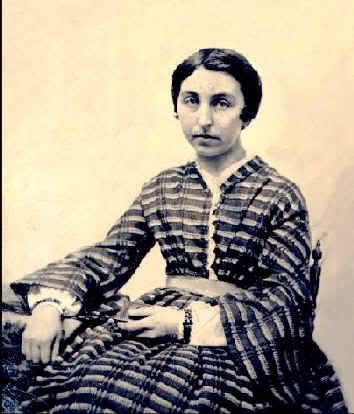Cause of death Pneumonia Role Author Name Amanda Jones | Spouse(s) Never married Nationality American Books A Psychic Autobiography | |
 | ||
Born October 19, 1835 ( 1835-10-19 ) East Bloomfield, NY Resting place Riverside Cemetery, Cleveland, OH Occupation InventorPoetess & authorSpiritualist Parent(s) Henry and Mary Alma Mott Jones Died March 31, 1914, Brooklyn, New York City, New York, United States | ||
Amanda Theodosia Jones (October 19, 1835 – March 31, 1914) was an American author and inventor, most noted for inventing a vacuum method of canning called the Jones Process.
Contents
- How technology is blurring the line between our work and home lives amanda jones tedxyouth mbjh
- Early life and education
- Literary publications
- Books
- Ladies Repository of Cincinnati Publications
- Influence of spiritualism
- Patents and inventions 18721880
- Founding of Womens Canning and Preserving Company 1890
- Later life
- References
How technology is blurring the line between our work and home lives amanda jones tedxyouth mbjh
Early life and education
Jones was born in East Bloomfield, New York, on October 19, 1835, the fourth child of Henry and Mary Alma (Mott) Jones. She attended district schools in East Bloomfield and Black Rock, New York; she completed normal school training at the East Aurora Academy in New York and began teaching at the age of fifteen.
Literary publications
She quit teaching in 1854 after her first poem was published by the Ladies' Repository of Cincinnati. In 1861, she published Ulah, and Other Poems; a second book of verse, Poems, was published in 1867. Her health had been fragile since contracting tuberculosis in 1859; after the publication of Poems, she spent a year recuperating at the home of her widowed mother in Wisconsin.
Books
Jones published six books in her lifetime. All are available online at the Internet Archive.
- Ulah: And Other Poems. Jones, Amanda T. Buffalo: H.H. Otis. 1861
- Poems. By Amanda T. Jones, Published/Created: New York, Hurd and Houghton, 1867.
- A Prairie Idyl, and Other Poems. Published/Created: Chicago, Jansen, McClurg & company, 1882.
- Rubáiyát of Solomon, and Other Poems. By Amanda T. Jones; Introduction by J. N. Larned. Published/Created: New York, Alden brothers, 1905.
- Poems, 1854–1906, by Amanda T. Jones. Published/Created: New York, Alden Brothers, 1906.
- A Psychic Autobiography / by Amanda T. Jones; with introduction by James H. Hyslop. Published/Created: New York: Greaves Publishing Co., c1910.
Ladies Repository of Cincinnati Publications
Between 1855 and 1864 Jones published frequently in the Ladies Repository. These poems, along with one she published in Overland Monthly and Out West magazine in 1894, are available at the University of Michigan's Making of America Journals digital library.
Influence of spiritualism
Influenced by the writings of Thomas Dick and the spiritualism movement, Jones became a convert to spiritualism in 1854 and believed herself to be a medium. In 1869, believing that the spirits wanted her there, she moved to Chicago, where she wrote for a number of periodicals, including Western Rural, Universe, Interior, and Bright Sides.
Patents and inventions – 1872–1880
In 1872, Jones developed a vacuum canning process for preserving food, with the help of Professor Leroy C. Cooley of Albany, who was the brother-in-law of her sister Emily. The following year she obtained five patents relating to her process, of which two listed her as sole inventor. Again following the advice of the spirits she communicated with, she developed another invention, an oil burner, which she patented in 1880. However, her attempts to establish businesses based on her inventions were unsuccessful, and she returned to writing, publishing A Prairie Idyll in 1882. There is one reference (Stanley, Autumn – See Bibliography) that maintains she has a patent for a Ready-Opener Tin Can, but that is the only, unsupported, reference to this patent.
Founding of Women's Canning and Preserving Company – 1890
A strong supporter of women's rights and suffrage, she founded the Women's Canning and Preserving Company in Chicago in 1890, which employed only women. In an address to her employees, Jones said that "This is a woman's industry. No man will vote our stock, transact our business, keep our books, pronounce on women's wages, supervise our factories. Give men whatever work is suitable, but keep the governing power. This is a business training school for working women – you with all the rest. Here is a mission; let it be fulfilled." When this venture failed in 1893, she left Chicago for Junction City, Kansas, where two of her sisters lived.
Later life
Jones continued to work with both of her inventions, obtaining patents on the canning process in 1903, 1905, and 1906, and additional patents relating to the oil burner in 1904, 1912, and 1914. She continued to publish occasional literary works, including the Rubaiyat of Solomon and Other Poems in 1905.
Following the Spanish–American War the U.S. Navy began investigating the transition from coal fired ships to oil. In 1904 they released a 489-page report which detailed extensively a comparison between coal and oil. Jones was asked to write a technical review of the report for Engineer: With which is Incorporated Steam Engineering. According to her obituary she was paid liberally for her contribution of four articles in 1904 and 1905. Those articles are online at the HathiTrust:
In 1910, she published her autobiography, A Psychic Autobiography, which focused on her interest in spiritualism. Late in her life, she moved to Brooklyn, New York, to pursue business interests, where she died of influenza in 1914. She was listed in Who's Who in America for 1912–13 and in Woman's Who's Who in America for 1914–15.
She is buried in Riverside Cemetery, Cleveland, Ohio in her brother William's plot.
